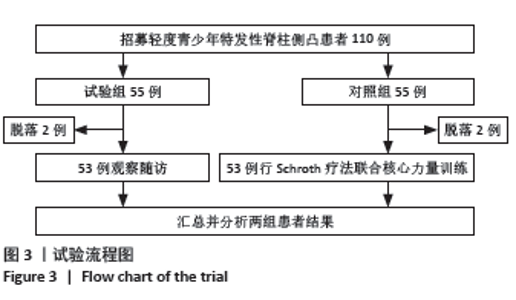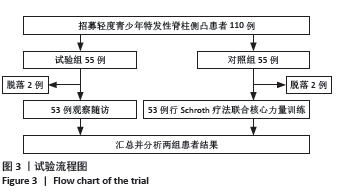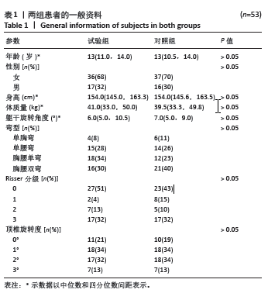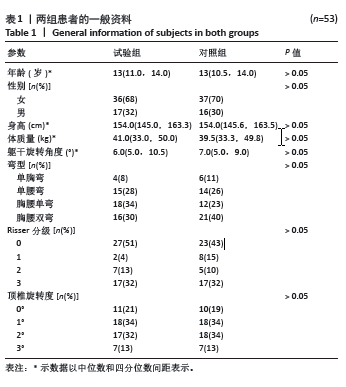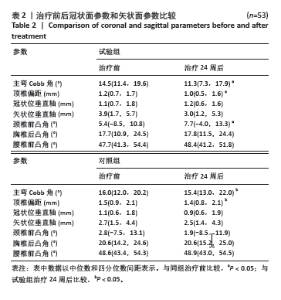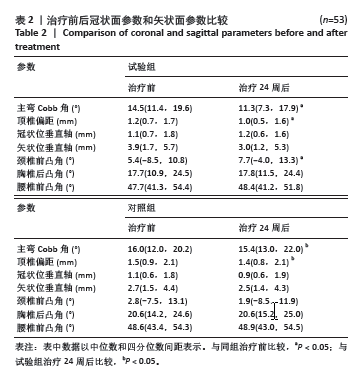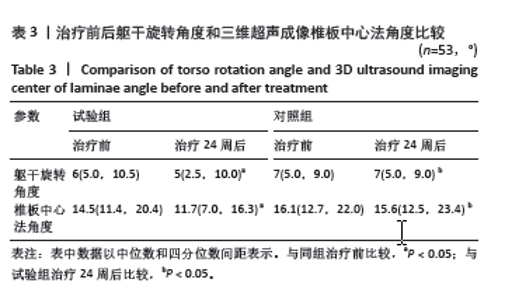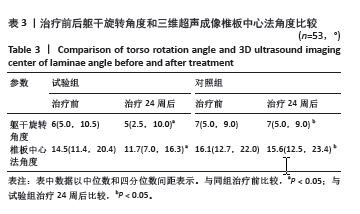Chinese Journal of Tissue Engineering Research ›› 2025, Vol. 29 ›› Issue (27): 5876-5882.doi: 10.12307/2025.185
Previous Articles Next Articles
Schroth therapy combined with core strength training improves scoliosis angle in patients with mild adolescent idiopathic scoliosis
Zhang Juanjuan1, 2, Jiang Nannan1, 2, Wu Yajun1, Gu Qian1, He Linfei1, Ji Yongxin1, Liu Su1
- 1Department of Rehabilitation Medicine, Affiliated Hospital of Nantong University, Nantong 226001, Jiangsu Province, China; 2School of Nursing and Rehabilitation, Nantong University, Nantong 226001, Jiangsu Province, China
-
Received:2024-02-24Accepted:2024-04-28Online:2025-09-28Published:2025-03-06 -
Contact:Liu Su, Professor, Master’s supervisor, Department of Rehabilitation Medicine, Affiliated Hospital of Nantong University, Nantong 226001, Jiangsu Province, China -
About author:Zhang Juanjuan, Department of Rehabilitation Medicine, Affiliated Hospital of Nantong University, Nantong 226001, Jiangsu Province, China; School of Nursing and Rehabilitation, Nantong University, Nantong 226001, Jiangsu Province, China -
Supported by:Jiangsu Province Research Hospital Foundation, No. YJXYY202204-XKB07 (to LS)
CLC Number:
Cite this article
Zhang Juanjuan, Jiang Nannan, Wu Yajun, Gu Qian, He Linfei, Ji Yongxin, Liu Su. Schroth therapy combined with core strength training improves scoliosis angle in patients with mild adolescent idiopathic scoliosis[J]. Chinese Journal of Tissue Engineering Research, 2025, 29(27): 5876-5882.
share this article
Add to citation manager EndNote|Reference Manager|ProCite|BibTeX|RefWorks
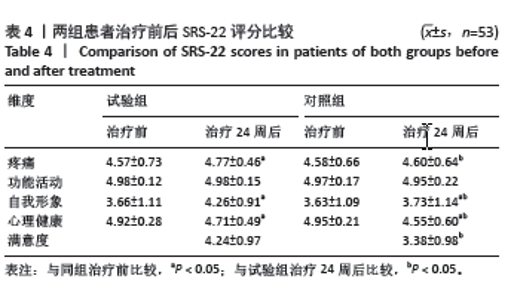
2.4.3 治疗前后三维超声成像评估比较 治疗前,试验组和对照组三维超声成像椎板中心法角度无显著差异(P > 0.05);治疗24周后,试验组角度明显减小 (P < 0.05),而对照组无显著差异(P > 0.05);试验组改善明显优于对照组(P < 0.05),见表3。 2.4.4 治疗前后生活质量比较 治疗前,试验组和对照组SRS-22在疼痛、功能活动、自我形象、心理健康维度无显著差异(P > 0.05);治疗24周后,试验组的疼痛维度评分显著增高(P < 0.05);试验组和对照组的自我形象维度评分均较治疗前显著增高(P < 0.05),心理健康维度评分均比治疗前显著降低(P < 0.05)。在疼痛、自我形象、心理健康和满意度维度评分方面,试验组均明显高于对照组(P < 0.05),见表4。 2.5 不良事件 此次研究中,试验组中有3例在运动过程中出现轻微头晕、恶心、呕吐症状,休息数分钟后完全缓解,后续治疗中未再发生类似反应。其他患者无不良反应。"
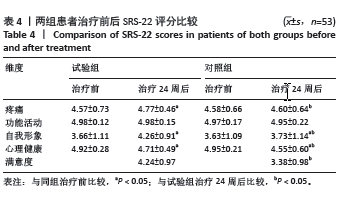
| [1] CHENG JC, CASTELEIN RM, CHU WC, et al. Adolescent idiopathic scoliosis. Nat Rev Dis Primers. 2015;1:15030. [2] WEINSTEIN SL, DOLAN LA, CHENG JC, et al. Adolescent idiopathic scoliosis. Lancet. 2008;371(9623):1527-1537. [3] SANDERS AE, ANDRAS LM, IANTORNO SE, et al. Clinically Significant Psychological and Emotional Distress in 32% of Adolescent Idiopathic Scoliosis Patients. Spine Deform. 2018;6(4):435-440. [4] THÉROUX J, STOMSKI N, HODGETTS CJ, et al. Prevalence of low back pain in adolescents with idiopathic scoliosis: a systematic review. Chiropr Man Therap. 2017;25:10. [5] WEINSTEIN SL. The Natural History of Adolescent Idiopathic Scoliosis. J Pediatr Orthop. 2019;39(Issue 6, Supplement 1 Suppl 1):S44-S46. [6] LIU D, YANG Y, YU X, et al. Effects of Specific Exercise Therapy on Adolescent Patients with Idiopathic Scoliosis: A Prospective Controlled Cohort Study. Spine (Phila Pa 1976). 2020;45(15):1039-1046. [7] KORBEL K, KOZINOGA M, STOLIŃSKI Ł, et al. Scoliosis Research Society (SRS) Criteria and Society of Scoliosis Orthopaedic and Rehabilitation Treatment (SOSORT) 2008 Guidelines in Non-Operative Treatment of Idiopathic Scoliosis. Pol Orthop Traumatol. 2014;79:118-122. [8] NEGRINI S, DONZELLI S, AULISA AG, et al. 2016 SOSORT guidelines: orthopaedic and rehabilitation treatment of idiopathic scoliosis during growth. Scoliosis Spinal Disord. 2018;13:3. [9] 靳梦蝶,周璇,李欣,等.特定运动疗法对特发性脊柱侧弯的效果[J].中国康复理论与实践,2022,28(7):841-847. [10] WEISS HR, LEHNERT-SCHORTH C, MOROMORCO M, 等著.施罗特治疗-保守脊柱侧弯治疗新发展[M].吴淑仁,译.香港:喜曼拿医疗系统有限公司,2015. [11] YILDIRIM S, OZYILMAZ S, ELMADAG NM, et al. Effects of Core Stabilization Exercises on Pulmonary Function, Respiratory Muscle Strength, Peripheral Muscle Strength, Functional Capacity, and Perceived Appearance in Children With Adolescent Idiopathic Scoliosis: A Randomized Controlled Trial. Am J Phys Med Rehabil. 2022;101(8):719-725. [12] KIM W, PORRINO JA, HOOD KA, et al. Clinical Evaluation, Imaging, and Management of Adolescent Idiopathic and Adult Degenerative Scoliosis. Curr Probl Diagn Radiol. 2019;48(4):402-414. [13] 袁望舒,陈丽霞,沈建雄,等.不同年龄、性别和类型的特发性脊柱侧凸患者轴向躯干旋转角度与Cobb角度的相关性[J].中国组织工程研究,2021,25(27):4386-4389. [14] JIANG WW, ZHOU GQ, LAI KL, et al. A fast 3-D ultrasound projection imaging method for scoliosis assessment. Math Biosci Eng. 2019;16(3): 1067-1081. [15] 陈绍丰,李博,周潇逸,等.青少年特发性脊柱侧凸相关生活质量评价量表现状[J].第二军医大学学报,2020,41(11):1188-1192. [16] CEBALLOS LAITA L, TEJEDOR CUBILLO C, MINGO GÓMEZ T, et al. Effects of corrective, therapeutic exercise techniques on adolescent idiopathic scoliosis. A systematic review. Arch Argent Pediatr. 2018;116(4): e582-e589. [17] SCHREIBER S, PARENT EC, KHODAYARI MOEZ E, et al. Schroth Physiotherapeutic Scoliosis-Specific Exercises Added to the Standard of Care Lead to Better Cobb Angle Outcomes in Adolescents with Idiopathic Scoliosis - an Assessor and Statistician Blinded Randomized Controlled Trial. PloS One. 2016;11(12): e0168746. [18] GÜR G, AYHAN C, YAKUT Y. The effectiveness of core stabilization exercise in adolescent idiopathic scoliosis: A randomized controlled trial. Prosthet Orthot Int. 2017;41(3):303-310. [19] DIMITRIJEVIĆ V, VIDUKA D, ŠĆEPANOVIĆ T, et al. Effects of Schroth method and core stabilization exercises on idiopathic scoliosis: a systematic review and meta-analysis. Eur Spine J. 2022;31(12): 3500-3511. [20] KOCAMAN H, BEK N, KAYA MH, et al. The effectiveness of two different exercise approaches in adolescent idiopathic scoliosis: A single-blind, randomized-controlled trial. PloS One. 2021;16(4):e0249492. [21] 陈楠,王熙,伍勰,等.特发性脊柱侧弯青少年的脊柱本体感觉与功能性动作特征[J]. 医用生物力学,2021,36(S1):161. [22] MCLAIN RF. Mechanoreceptor endings in human cervical facet joints. Spine (Phila Pa 1976). 1994;19(5):495-501. [23] WIERNICKA M, KOTWICKI T, KAMIŃSKA E, et al. Postural Stability in Adolescent Girls with Progressive Idiopathic Scoliosis. Biomed Res Int. 2019; 2019:7103546. [24] 张宸洁,董静梅.青少年特发性脊柱侧凸的神经—肌肉系统调控机制研究进展[J].中国学校卫生,2023,44(8):1266-1271. [25] SCHLÖSSER TPC, CASTELEIN RM, GROBOST P, et al. Specific sagittal alignment patterns are already present in mild adolescent idiopathic scoliosis. Eur Spine J. 2021;30(7):1881-1887. [26] 陈思思,周璇,李欣,等.女性青少年特发性脊柱侧凸颈椎形态对康复疗效的影响[J].中国康复医学杂志,2023,38(8):1062-1065+1078. [27] NEWTON PO, OSBORN EJ, BASTROM TP, et al. The 3D Sagittal Profile of Thoracic Versus Lumbar Major Curves in Adolescent Idiopathic Scoliosis. Spine Deform. 2019;7(1):60-65. [28] WEISS HR, KLEIN R. Improving excellence in scoliosis rehabilitation: a controlled study of matched pairs. Pediatr Rehabil. 2006;9(3):190-200. [29] SUNAMI T, KOTANI T, AOKI Y, et al. Large Lumbar Lordosis Is a Risk Factor for Lumbar Spondylolysis in Patients with Adolescent Idiopathic Scoliosis. Spine (Phila Pa 1976). 2022;47(1):76-81. [30] 卜时嬴,袁望舒,陈丽霞,等.青少年特发性脊柱侧凸Cobb角度与躯干旋转角度及体重指数的相关性[J].中华骨与关节外科杂志, 2023,16(10):886-890. [31] KURU T, YELDAN İ, DERELI EE, et al. The efficacy of three-dimensional Schroth exercises in adolescent idiopathic scoliosis: a randomised controlled clinical trial. Clin Rehabil. 2016;30(2):181-190. [32] LEE TY, YANG D, LAI KK, et al. Three-dimensional ultrasonography could be a potential non-ionizing tool to evaluate vertebral rotation of subjects with adolescent idiopathic scoliosis. JOR Spine. 2023;6(3): e1259. [33] 何红晨,王谦,柳学明,等.三维超声用于青少年特发性脊柱侧凸评估的信度与效度研究[J].中国康复医学杂志,2017,32(2): 146-150. [34] WANG Q, LI M, LOU EH, et al. Reliability and Validity Study of Clinical Ultrasound Imaging on Lateral Curvature of Adolescent Idiopathic Scoliosis. PloS One. 2015;10(8):e0135264. [35] LAI KK, LEE TT, LEE MK, et al. Validation of Scolioscan Air-Portable Radiation-Free Three-Dimensional Ultrasound Imaging Assessment System for Scoliosis. Sensors (Basel). 2021;21(8):2858. [36] BRINK RC, WIJDICKS SPJ, TROMP IN, et al. A reliability and validity study for different coronal angles using ultrasound imaging in adolescent idiopathic scoliosis. Spine J. 2018;18(6):979-985. [37] LEE TT, LAI KK, CHENG JC, et al. 3D ultrasound imaging provides reliable angle measurement with validity comparable to X-ray in patients with adolescent idiopathic scoliosis. J Orthop Translat. 2021;29:51-59. [38] LIU D, YANG Y, YU X, et al. Effects of Specific Exercise Therapy on Adolescent Patients with Idiopathic Scoliosis: A Prospective Controlled Cohort Study. Spine. 2020;45(15):1039-1046. [39] 赵黎,张勇,尚磊,等.中文版SRS-22问卷在中国青少年特发性脊柱侧凸患者评价中的应用(跨文化修订和可信度分析)(二) [J]. 中国矫形外科杂志,2008,16(14):1072-1073+1087. [40] ZHANG X, WANG D, YAO M, et al. Reliability and validity of Chinese version of brace questionnaire for adolescent idiopathic scoliosis: A cross-sectional study. Medicine (Baltimore). 2021;100(33):e26965. [41] GAO A, LI JY, SHAO R, et al. Schroth exercises improve health-related quality of life and radiographic parameters in adolescent idiopathic scoliosis patients. Chin Med J (Engl). 2021;134(21):2589-2596. [42] ANWER S, ALGHADIR A, ABU SHAPHE M, et al. Effects of Exercise on Spinal Deformities and Quality of Life in Patients with Adolescent Idiopathic Scoliosis. Biomed Res Int. 2015;2015:123848. [43] SCHREIBER S, PARENT EC, HILL DL, et al. Patients with adolescent idiopathic scoliosis perceive positive improvements regardless of change in the Cobb angle - Results from a randomized controlled trial comparing a 6-month Schroth intervention added to standard care and standard care alone. SOSORT 2018 Award winner. BMC Musculoskelet Disord. 2019;20(1):319. |
| [1] | Zheng Huakun, Yin Mingyue, Liu Qian. Effects of interval and continuous training on the quality of life in physically inactive adults: a meta-analysis [J]. Chinese Journal of Tissue Engineering Research, 2025, 29(8): 1727-1740. |
| [2] | Zheng Xiaodong, Gao Shan, Han Wenjin, Liu Lijun, Jia Menglong, Yu Longtan. Visual analysis of treatment of adolescent idiopathic scoliosis [J]. Chinese Journal of Tissue Engineering Research, 2025, 29(3): 645-653. |
| [3] | Li Jia, Liu Qianru, Xing Mengnan, Chen Bo, Jiao Wei, Meng Zhaoxiang. A network meta-analysis on therapeutic effect of different types of exercise on knee osteoarthritis patients [J]. Chinese Journal of Tissue Engineering Research, 2025, 29(3): 609-616. |
| [4] | Liu Jing, Xu Chunxin, Lu Yangyang, Qu Qinquan, Zhu Qi, Guo Yulan, Shen Min. Correlation of gait parameters and muscle parameters with imaging in adolescent idiopathic scoliosis patients [J]. Chinese Journal of Tissue Engineering Research, 2025, 29(21): 4477-4485. |
| [5] | Yue Bo, Cao Zhenhua, Zhang Yunfeng, Xu Yangyang, Jin Feng, Su Baoke, Wang Lidong, Wang Xing, Tong Ling, Liu Qinghua, Fang Yuan, Sha Lirong, Wang Haiyan, Li Xiaohe, Li Zhijun. Biomechanical characteristics of different orthopedic modalities for adolescent idiopathic scoliosis based on finite element simulation analysis [J]. Chinese Journal of Tissue Engineering Research, 2025, 29(15): 3129-3137. |
| [6] | Wu Maodong, Su Qinglun, Huang Yiming, Shen Longying, Lu Yu, Zhao Qin. Correlation between coronal pressure variation and coronal imbalance in adolescent idiopathic scoliosis patients [J]. Chinese Journal of Tissue Engineering Research, 2024, 28(6): 852-856. |
| [7] | Chang Ying, Xia Yuan, Sun Yundi, Cheng Lulu, Xiong Wenjuan, Zhao Xianghu. Effectiveness of different specific exercise therapies in treatment of adolescent idiopathic scoliosis: a network meta-analysis [J]. Chinese Journal of Tissue Engineering Research, 2024, 28(36): 5899-5904. |
| [8] | Hou Yutong, Huang Chenglan, Yang Yunxiao, Li Ya, Guo Peiwu, Yu Wenqiang, Zhao Yu, Wang Zanbo, Zeng Hong, Ma Zhenjiang, Lu Dezhi, Wang Jinwu. Correlation between lumbar spine and pelvic parameters in Lenke type 5 adolescent idiopathic scoliosis [J]. Chinese Journal of Tissue Engineering Research, 2024, 28(36): 5753-5758. |
| [9] | Hou Zhaomeng, Su Shaoting, Chen Longhao, Wei Guikang, Zhou Honghai. Visualization analysis of research hotspots and trends in adolescent idiopathic scoliosis [J]. Chinese Journal of Tissue Engineering Research, 2024, 28(21): 3424-3430. |
| [10] | Xin Xiaoming, Gao Mingxuan, Zhang Fan, Chi Fei, Feng Junchao, Luo Wenyuan. Application of orthopedic robot-assisted screw placement in the correction of adolescent idiopathic scoliosis [J]. Chinese Journal of Tissue Engineering Research, 2023, 27(36): 5790-5794. |
| [11] | Peng Lu, Duan Zhili, Li Zhenyu, Li Junhui, Li Yunhong, Wang Song, Liu Weiqiang. Research status and progress of establishment and validation of finite element model of adolescent idiopathic scoliosis [J]. Chinese Journal of Tissue Engineering Research, 2023, 27(27): 4393-4400. |
| [12] | Zhang Duo, Shan Jixin. Alteration in knee and ligament functions in patients with knee ligament injury under aerobic training intervention mode [J]. Chinese Journal of Tissue Engineering Research, 2023, 27(26): 4107-4112. |
| [13] | Wang Shuai, Wang Liancheng, Zhang Shuhao, Li Fuli, Dong Jiaxing, Zhang Yajie. Correlation of the electromyography ratio of the paraspinal muscles on the convex and concave sides with Cobb angle, apical vertebra translation, and coronal balance distance in adolescent idiopathic scoliosis patients [J]. Chinese Journal of Tissue Engineering Research, 2022, 26(9): 1402-1406. |
| [14] | Li Yuqiao, Sun Tianwei, Ma Bin, Zhou Zhaohong, Dong Runbei, Wu Haiyang. A comparative study of imaging parameters and quality of life scores between subtypes of lumbar spondylolisthesis [J]. Chinese Journal of Tissue Engineering Research, 2022, 26(6): 943-948. |
| [15] | Lu Yangyang, Xu Chunxin, Chen Cen, Ren Jie, Zhai Xinyi, Zhu Shenyu, Shen Min. Establishment of thoracic and abdominal volume models of adolescent idiopathic scoliosis based on three-dimensional motion capture system [J]. Chinese Journal of Tissue Engineering Research, 2022, 26(36): 5807-5811. |
| Viewed | ||||||
|
Full text |
|
|||||
|
Abstract |
|
|||||
